 Improving energy efficiency in your home not only helps reduce your environmental footprint but also saves you money on utility bills.
Improving energy efficiency in your home not only helps reduce your environmental footprint but also saves you money on utility bills.
Today, we’ll explore various ways to enhance your home’s energy efficiency, creating a more sustainable and cost-effective living environment.
1. Upgrade Your Insulation
Proper insulation helps maintain a consistent indoor temperature and reduces the need for heating or cooling. Inspect your home for insulation gaps or signs of wear, and consider adding or replacing insulation where needed, especially in attics and walls.
2. Seal Air Leaks
Air leaks around doors, windows, and ducts can lead to significant energy waste. Seal these gaps with weatherstripping, caulk, or expanding foam to prevent heated or cooled air from escaping.
3. Install Energy-Efficient Windows
Energy-efficient windows with double or triple glazing and low-emissivity coatings help insulate your home and reduce heat transfer. They also provide better protection from outdoor temperatures.
4. Upgrade Appliances
Old appliances, especially refrigerators, washing machines, and dishwashers, can consume more energy than modern, energy-efficient models. Look for appliances with ENERGY STAR certification, which are designed to save energy and reduce utility costs.
5. Programmable Thermostat
A programmable thermostat allows you to set heating and cooling schedules, optimizing temperature control while reducing energy consumption when you’re not at home or during the night.
6. Switch to LED Lighting
LED bulbs are highly energy-efficient and last much longer than traditional incandescent bulbs. Replacing your old bulbs with LEDs can significantly reduce your lighting energy consumption.
7. Regular HVAC Maintenance
Schedule regular maintenance for your heating, ventilation, and air conditioning (HVAC) system. Clean filters, check for leaks, and ensure the system is running efficiently. An efficient HVAC system can save you money on heating and cooling costs.
8. Use Renewable Energy Sources
Consider installing solar panels or wind turbines to harness renewable energy. While this may require an upfront investment, it can lead to substantial long-term savings and reduced reliance on non-renewable energy sources.
9. Reduce Water Heating Costs
Insulate your water heater and set it to a lower temperature to reduce energy usage. Fix any leaks in faucets or pipes to avoid wasting hot water. Consider upgrading to a tankless water heater for on-demand hot water without energy loss.
10. Optimize Landscaping
Strategic landscaping can provide shade to your home in the summer and windbreaks in the winter, reducing the workload on your HVAC system. Planting trees or shrubs in the right locations can create a more energy-efficient home.
Increasing energy efficiency in your home benefits both your wallet and the environment. By taking these steps to improve insulation, seal air leaks, upgrade appliances, and adopt renewable energy sources, you can create a more sustainable and cost-effective living space. These changes not only reduce your carbon footprint but also contribute to a more comfortable and energy-efficient home.
Picture Credit: Freepik



